Dateline – September 2020
Occasionally, I don’t have to venture any further than my own front yard for an interesting urban wildlife encounter. Such is the case with the story I will relate in this article. Here’s how it happened…
Early one fall, a few years ago, I was busying myself about the house with some end-of-season yard work. The project for the day was to cut back our hedges–not one of my favorite jobs. Our landscaping is quite extensive, and some of the work requires squeezing into places that are not so easy to reach. At one point in the project, I found myself wedged between our house and one of our larger bushes. There was a small clearing back there that was not really visible from the lawn. It had just enough room for me to stand in, but it was difficult to get to. This may have been the first time it had been directly visited by a person in years.
In this forgotten corner of our yard, I made a somewhat disturbing discovery. On the bare ground next to our house I found the decapitated carcasses of a rather large Eastern Cottontail–the obvious victim of predation. But what had killed the hapless rabbit? In our neighborhood we have several candidate predators: Bobcats, Coyotes, Red-tailed Hawks, and Great Horned Owls, to name a few. All have been observed around our house at one time or another. The question was, would there be enough evidence to determine which one was responsible for the dead rabbit?

I began looking for clues, but there were few to be found. The most compelling hint may have been the tight quarters behind the bushes. It would have been very challenging for a large bird of prey to get in through the tangle of branches and leaves. I also didn’t feel like this had the signs of being a Coyote kill, despite the fact that Coyotes had been observed around our house on a number of occasions. Coyotes typically frequent our neighborhood greenbelt, and travel our streets in dusky conditions, but rarely have they been seen poking around in people’s yards and landscaping.
All things considered, I started to suspect that the predator was likely feline, possibly one of the several Bobcats that frequent our neighborhood. But then again, maybe not–abandoning a fresh kill is not typical wild predator behavior, and I began to judge the condition of the dead cottontail to be the most telling bit of evidence. The headless–but uneaten carcass, combined with the constrained location where the carcass was found, suggested one predator above all the others. I decided to set a trail camera or two in order to verify my suspicions.
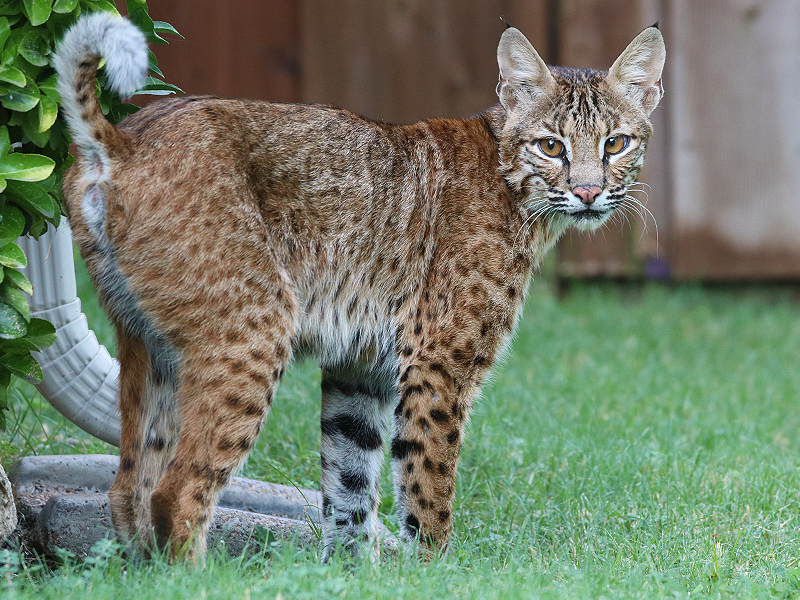
Could this be the predator hunting rabbits in my front yard?
Remarkably, it only took a few days to get the answer I was looking for. As I suspected, it turned out our culprit was a domestic House Cat! But instead of coming back to feed on the existing rabbit carcass, the big tabby surprised me by returning with a fresh kill! Apparently, this tomcat had just begun hunting cottontails, and he was now getting pretty good at it.
The cat did not eat the first rabbit he had killed, which is fairly typical behavior for a well fed pet. A House Cat just learning to hunt, either won’t be hungry enough to feed on its freshly killed prey, or it may not even fully understand that the cottontail it has just killed CAN be consumed. Whatever the case, the first rabbit carcass I discovered remained uneaten, but the same would not true for the cat’s second victim.
My trail camera pictures revealed that the tabby seemed to appreciate the privacy and cover provided by our landscaping. It allowed him to feed at his leisure. That may best explain why he came back to the same spot with his second kill.
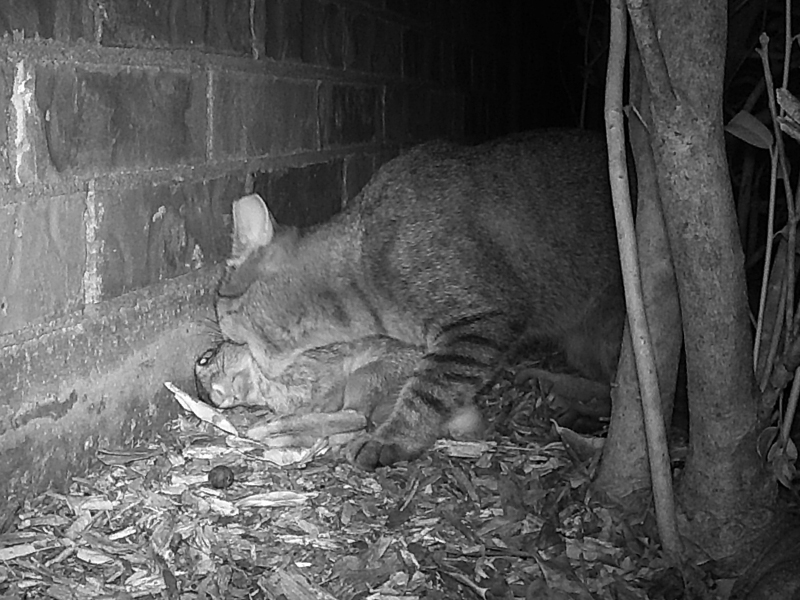
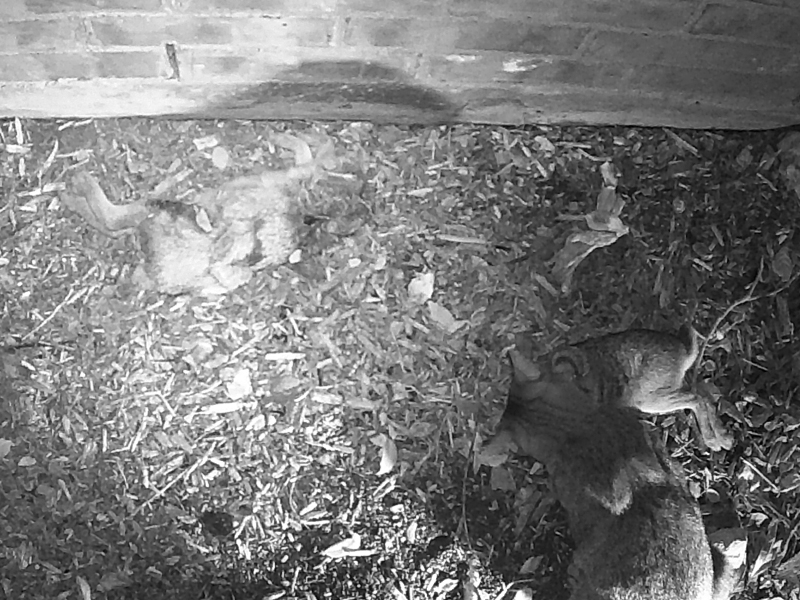

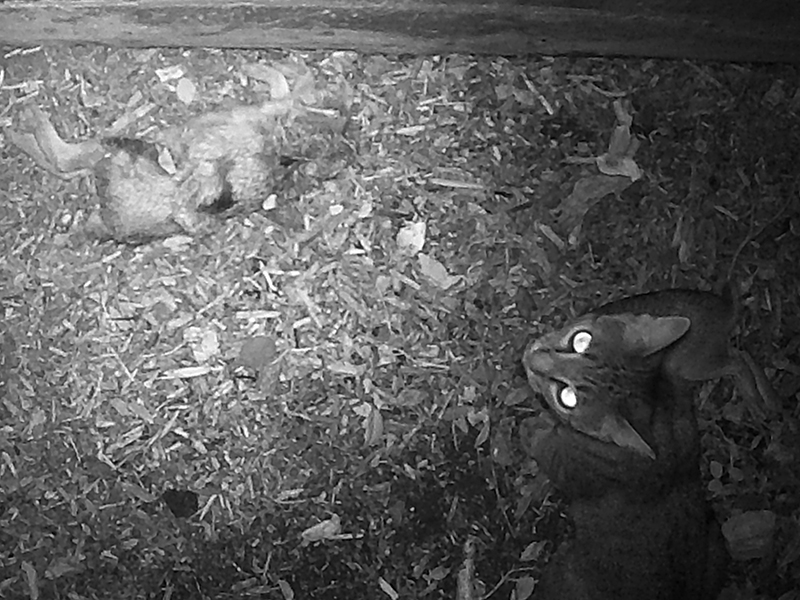

Later, a second, slightly smaller tabby showed up to investigate the scene. Easy to differentiate from the first cat by the collar he wore, he made made many repeat visits to the site. This tabby was also very interested in both rabbit carcasses, which he investigated thoroughly each time he stopped by. He was even seen to pick one up in his mouth on occasion, but he never fed on either one. He was also never seen to hunt.
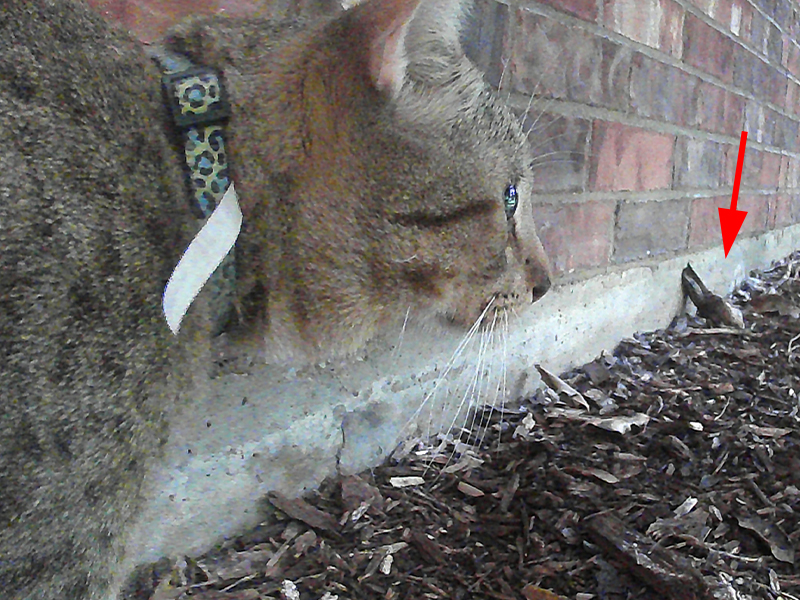
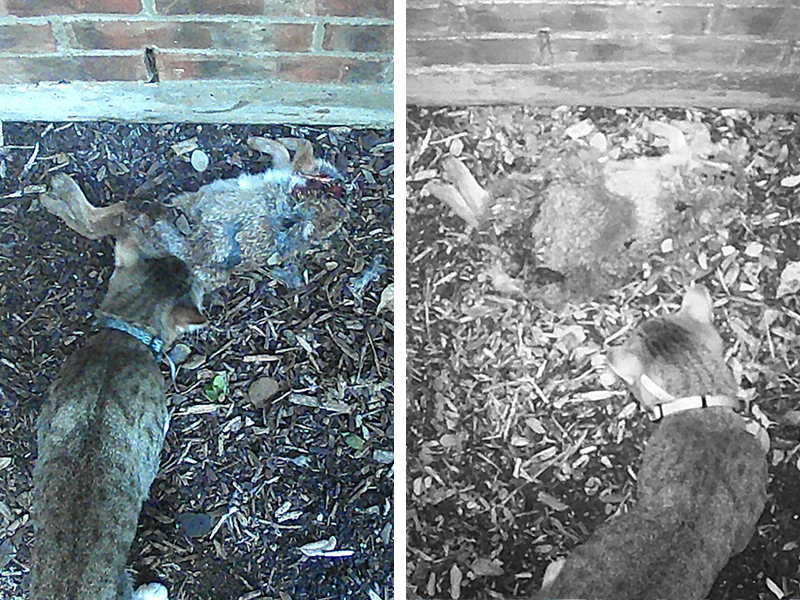

I left my trail cameras to run for a few weeks longer, and the cats continued to come back with some regularity, but there were no more dead rabbits. It seems as though the first tabby had mastered his hunting technique and then quickly lost interest., Or maybe he had other hideouts, in other yards, that he prefers to this one. Whatever the case, this scenario has not repeated in the three years since the original carcass was found.
I don’t know who these cats belong to, but I do still notice them around the house from time to time. Both like to lounge on our upholstered patio furniture, and I’m happy to let them do it. Sometimes I’ll catch a glimpse of them when I lift the blinds up for a peek out, and they always look very comfortable! Other times I might flush one or the other when I step out front to check the mail. As an added bonus, my dogs get a big kick out of spending a minute or two sniffing the chairs for cat smells when we step outside for their morning walks.
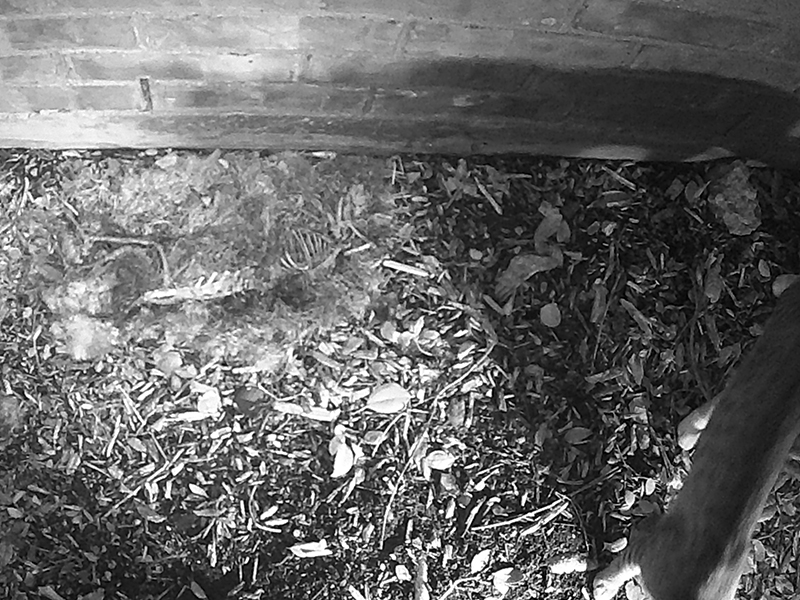
and the other was completely consumed
In closing, let me share on final thing of note with you. Over the course of this camera trapping project, I collected many pictures and much video footage. All together the images revealed that there is a LOT of wildlife activity that takes place in my front yard. Much drama! I think it’s fair to say that mine can be considered a representative case. I suspect that similar scenarios play themselves out all across the Dallas/Fort Worth metroplex everyday. I’m sure many folks would be surprised to learn about what kind of critters visit their yards and what they do while they are there
One interesting aspect of the footage I recorded this time around is that it often captured different critters moving through the exact same spaces. I used that as an opportunity to create the video below in hopes of better communicating the relative size of Bobcats as compared to House Cats–they are closer in size than most people realize. As you can see in the video below, the Bobcat has longer legs, and a slightly longer torso, but otherwise they are very close in size.
According to Wikipedia, Bobcats typically weigh in somewhere in the 9-40 pound range (females are smaller than males), while House Cats come in at around 8 to 10 pounds (but can be bigger). I would estimate the tabby cat in the video at 10 pounds or so, and the Bobcat at somewhere between 15 and 20 pounds.




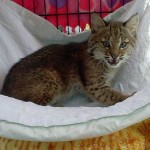

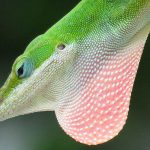
I see the mighty hunter tabby has a tipped ear, indicating it’s a TNR feral.
Very interesting report, Chris. One point you did not make, but that I will. According to researchers who work with The National Audubon Society, house cats, both pets and feral, are responsible for a very large fraction of small wildlife mortality in both rural and urban areas, especially of song birds, but mammals, reptiles, and invertebrates as well. Small wildlife is declining in North America, and likely world wide. I would say that your local cottontail population likely sustains itself well despite the cat predation, but perhaps your report may be a cautionary tale to some to keep their cats indoors (for their protection as well as protection of local wildlife). Thanks again Chris, for an enlightening report. I knew that house cats were capable of taking a cottontail, but have never actually witnessed the predation. I have seen a house cat successfully take a squirrel, and also several times fail to do so, as the squirrel escaped up a tree where the cat could not follow rapidly.
Your speculation about the possible evolution of urban populations of rabbits and squirrels to avoid vehicular traffic was interesting, also. I have seen squirrels, though not rabbits, negotiate a road with cars, feinting toward entering the road, then backing off as a car approached, then entering the road after the car passed. I have no idea about whether there is the kind of variation in caution/aggression in squirrel behavior, genetically controlled, that would result in a shift in vehicle avoidance over time due to weeding of genes for too much aggression, of course. But it is plausible.